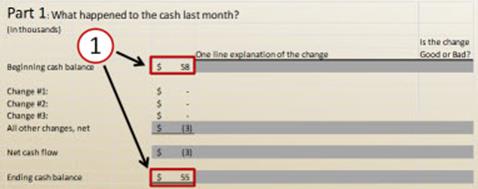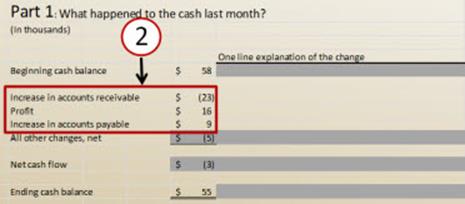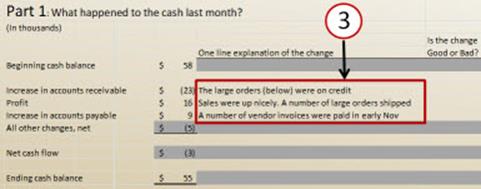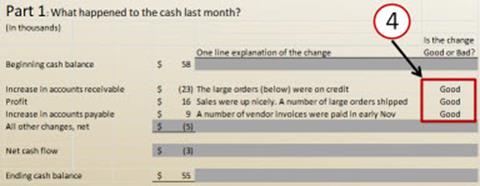In my last post, I introduced you to the Cash Flow Focus Report. It is a simple, common sense approach to understanding your cash flow that only takes 10 minutes a month. It is designed to bring focus to your cash flow and simplify your life (especially when it comes to understanding and managing cash flow). You will be surprised just how powerful this approach can be to creating confidence and control in your business.
Now I want to show you how to complete the Focus Report.
Create a blank Cash Flow Focus Report. You can create one on paper or in a spreadsheet.
(NOTE: I provided a spreadsheet version to those who attended my recent webinar titled Understanding Your Cash Flow – In Less Than 10 Minutes. The link also shows you how to download the Quick Start Guide and the Cash Flow Focus Report from the webinar. Grab it here.)
Here are the steps for completing the Focus Report.
Step 1: Drop in the beginning cash balance and the ending cash balance. Round the numbers from the cash flow statement in thousands. This is an important component of keeping things simple. So a beginning cash balance of $58,235 would be $58. (The XLS has a formula for automatically calculating “all other changes, net” and the “net cash flow” lines.)

Step 2: Identify the three largest changes in cash. Find the three largest changes of cash for the month from the Statement of Cash Flows you printed from your accounting system. Enter the category of change (like accounts receivable, profit or loss, inventory, accounts payable, debt service, etc.) and the amount of the change. Use the same sign (positive or negative) as is on the cash flow statement.

Step 3: Write a one-line explanation of the change. You will do that for each of the three largest changes. Keeping the explanation to one-line is important because it forces you to simplify your explanation. If there is a stumbling block in your way to writing your explanation it’s the fact that there are lots of different drivers of cash flow. And understanding those means you need to learn a little about how financial statements work. That’s a good thing though. You are severely handicapped in business if you do not have a good working knowledge of your financial statements.
The beauty of the Focus Report is that you do not have to learn about each one of these at one time. You get to learn about them in bite sized pieces. A little bit at a time. Trying to learn about all of them at once is like trying to drink water from a firehouse. It doesn’t work (and it’s not real smart).
I will be writing on my blog about what each change in cash means in the series titled Understanding the Drivers of Cash Flow. I will have a post talking about how to understand each driver so you can write your one-line explanation with confidence.
(This is also an area where my Fast Start Coaching Program might be a help to you.)

Step 4: Determine whether each change in cash is good or bad. You will do that for each of the three largest changes in cash. For example, if one of the changes was a pay down on debt of $20 thousand because you are in the process of paying debt down quickly, then that would be shown as good. If that same $20 thousand reduction in debt was because the bank threatened to pull your line of credit unless you paid it down ASAP (and it is going to put you in a bind financially) then that would be bad. Generally speaking, a change that catches you by surprise or might spell trouble financially, then it would be labeled as bad.

Try It
The goal is to spend less than 10 minutes a month to complete the Cash Flow Focus Report. The only thing that will slow you down in the first couple months is if you are uncertain how to explain one of the three large changes in cash.
My blog post series titled Understanding the Drivers of Cash Flow should help you. The first one focused on profitability.
Stay tuned for future posts on how to understand and manage each of the drivers of your cash flow.


Recent Comments